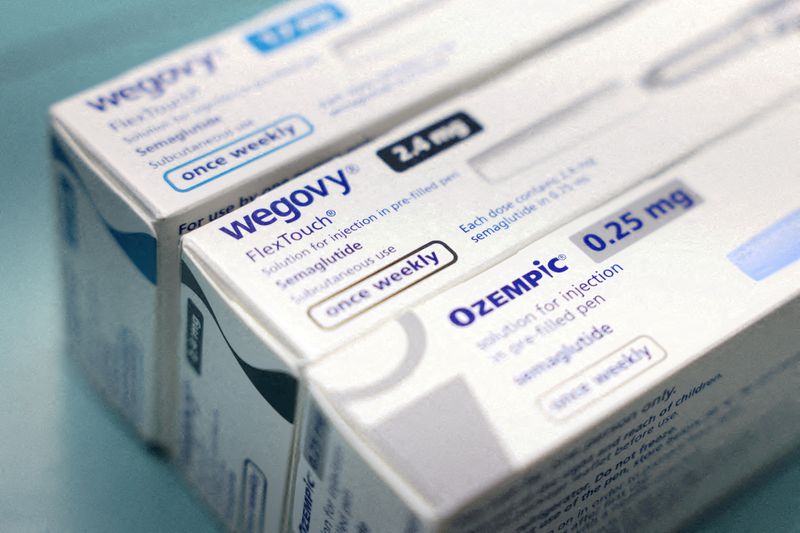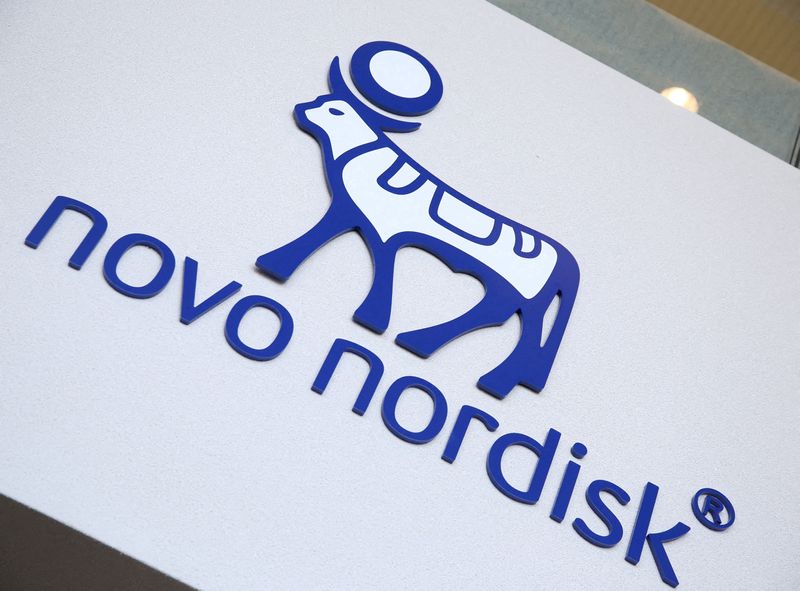By Maggie Fick
LONDON (Reuters) -Novo Nordisk on Wednesday trimmed its full-year profit outlook after reporting weaker-than-expected quarterly sales of its popular weight-loss drug Wegovy, stirring worries among investors about stiffening competition from Eli Lilly (NYSE:LLY).
The results end a prolonged streak of positive earnings news from the first mover in the obesity drug race which has seen its value surge to more than $500 billion, making it Europe's most valuable listed company.
Novo shares, which have soared some 230% since the company launched Wegovy in June 2021, fell as much as 7.7% in early trading and were still down 5.8% at 1410 GMT, putting them among the biggest fallers on the broader STOXX 600 and on track for their biggest one-day drop in two years.
Chief Financial Officer Karsten Munk Knudsen in an interview called the reaction unsurprising, given the market's sensitivity to Novo's mega-blockbuster drug Wegovy.
Second-quarter profit also missed expectations, and the softer results were "in sharp contrast to the massive sales and earnings beats we have seen last year", said Markus Manns, a portfolio manager at Novo shareholder Union Investment in Germany.
Novo, like U.S. rival Lilly, is racing to expand production capacity to meet runaway demand, with its dominance in the fast-growing obesity drug market, which some forecast could be worth about $150 billion by the early 2030s, at stake.
Some analysts found the company's upgrade to its sales outlook for this year - to between 22% and 28% in local currencies from 19% to 27% previously - to be a reassuring sign that Wegovy supplies are improving.
But in a mark of the challenge facing Novo, U.S. patients are on average staying on Wegovy for just six months, with an executive attributing the short time to the low availability of the wildly popular drug.
The company also said it will continue restricting supplies of the lowest or starter dose of Wegovy to the U.S., where that dose remains in shortage, according to the U.S. Food and Drug Administration website.
On Friday, the FDA updated its website to note that all dose strengths of Lilly's Zepbound are available. Lilly will release quarterly numbers on Thursday.
CONCESSIONS
CEO Lars Fruergaard Jorgensen downplayed concerns over competition from Lilly in a call with journalists, saying he did not see those dynamics having a big impact on sales in the foreseeable future, while demand far exceeds supply.
CFO Knudsen said U.S. prices of Wegovy were lower this year due to a variety of anticipated factors including price concessions to get insurance access in various channels.
Wegovy is now covered by Medicaid plans in 20 U.S. states, Novo said on Wednesday, and investors saw the increased access to the treatment at a lower cost as one factor that drove the Wegovy sales miss.
Sales of Wegovy, Novo's first-to-market weight-loss drug, rose 53% to 11.66 billion Danish crowns ($1.7 billion), well below the 13.54 billion expected by analysts, while those of Ozempic, a diabetes drug with the same active ingredient, also just missed expectations.
Second-quarter sales were also knocked by higher-than-expected rebates, or price concessions to U.S. pharmacy benefit managers. CFO Knudsen said it was a "quarterly blip".
The Danish company cut its operating profit growth forecast this year to between 20% and 28% in local currencies from 22% to 30% previously.
Novo ended an advanced kidney disease trial in June, resulting in a 5.7 billion Danish crown impairment loss which it said hit operating profit.
HEAD-TO-HEAD
Novo is spending billions of dollars to lift Wegovy production to meet demand and fend off Lilly, which launched its rival therapy Zepbound in the U.S. last December.
While the two companies are now going head-to-head with obesity treatments in a number of markets including Britain and Germany, the most lucrative one by far is the U.S., where more than 70% of adults are obese or overweight.

Novo also said it had withdrawn its submission to U.S. and European regulators for approval of Wegovy to treat heart failure and kidney disease, and plans to resubmit with more data at the start of 2025.
($1 = 6.8397 Danish crowns)
